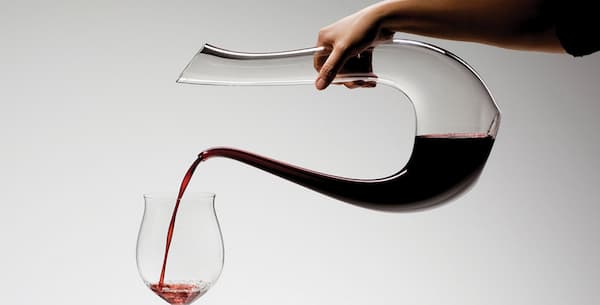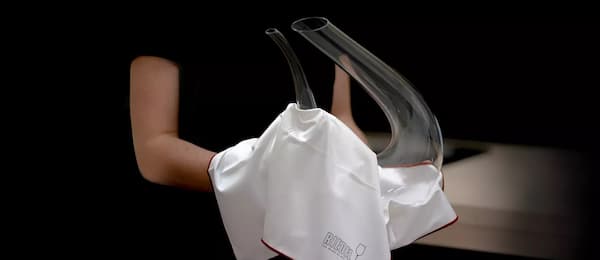
10 May, 2024
A Comprehensive Guide to Decanters: Selection, Usage, and Importance
I've often encountered questions about the purpose and selection of decanters. In this guide, I aim to shed light on the art and science of decanting, helping wine lovers understand why decanters are not just a symbol of sophistication but a tool for enhancing your wine experience.
Why Use a Decanter?
The primary reason for decanting is to ensure that the wine reaches its full potential. There are two main benefits:
1. Aeration
- Enhancing Complexity and Flavor: The interaction between wine and oxygen can significantly alter its profile. When wine is aerated through decanting, the exposure to air initiates oxidation and evaporation processes. This is particularly beneficial for robust red wines like Shiraz, Cabernet Sauvignon, or Merlot. These wines often have high tannin levels, which can be softened through aeration, making the wine more approachable and enjoyable.
- Unlocking Aromas: Many of the nuanced aromas in wine are volatile, meaning they evaporate quickly when exposed to air. Decanting facilitates the release of these aromatic compounds. This process can transform the wine, elevating subtle notes and allowing the bouquet to fully develop. For example, a young Barossa Valley Shiraz might reveal layers of dark fruit, spice, and chocolate notes upon proper aeration.
- Time Factor: The duration of aeration depends on the wine's character and age. Young, tannic wines may need more time to breathe, sometimes several hours, whereas more delicate wines, like a young Pinot Noir, might require less time. The process of aeration is about finding the sweet spot where the wine's qualities are optimally enhanced.
2. Separation from Sediments
- Understanding Sediments: Sediments in wine are natural and often occur in older wines. They are composed of tannins and pigments that have bonded together and fallen out of suspension over time. While they are harmless, they can be unpleasant to consume and can detract from the overall wine experience.
- The Decanting Process for Older Wines: For older wines, particularly those with noticeable sediment, decanting serves as a means to ensure clarity and purity in each glass. The process involves gently pouring the wine into the decanter, ensuring the sediments remain in the bottle and not in the decanter or your glass. It's a delicate operation, often done with a light source behind the bottle to see when the sediments start to approach the neck.
- Preserving Integrity: Older wines are generally more fragile and can be overwhelmed by excessive oxygen. Therefore, when decanting an aged wine, the goal is not so much aeration but rather the gentle separation from sediments. This is why decanters designed for older wines typically have a narrower base, as they don't need to expose the wine to as much air.
The use of a decanter is a testament to the respect and appreciation for the wine's journey from vineyard to glass. Whether it's the softening of tannins in a robust young red or the careful separation of sediment in an aged vintage, it can significantly enhance the wine-drinking experience. It's a ritual that celebrates the complexity and history of wine, allowing each bottle to express its fullest potential.
Choosing the Right Decanter

Selecting a decanter depends on the type of wine you are serving:
1. Young Red Wines
Think of wines like your vibrant Shiraz or a bold Cabernet Sauvignon. These are like energetic teenagers – they need some space to stretch out! So, for these wines, go for a decanter with a wide base. Why? It's all about giving them room to breathe. The wide base increases the wine's surface area, exposing more of it to air. This aeration softens those feisty tannins, making the wine smoother and bringing out all those hidden flavors and aromas. It's like watching the wine wake up and show off its best self!
2. Older Red Wines
Now, these are your wise, experienced wines, like a dignified Bordeaux or a sophisticated Pinot Noir. They've been around the block and gathered some sediment along the way. For these wines, choose a decanter with a narrow base and a wider neck. You're aiming for a gentle pour here. Think of it like handling a precious antique – with care and respect. This way, you keep the sediment undisturbed at the bottom of the bottle and out of your glass. It's all about enjoying the wine's depth without any gritty interruptions.
3. White Wines and Rosés
Traditionally, we don't talk about decanting these guys, but hey, rules are meant to be broken, right? Full-bodied whites like a Chardonnay or a Viognier can actually shine brighter with a bit of decanting. The trick here is not to overdo it. Use a simple, upright decanter. This gentle approach nudges the wine to open up, enhancing those beautiful, often subtle aromas and flavours. It's like giving the wine a chance to whisper its secrets.
In summary, picking a decanter is like choosing the right dance partner for your wine. Match their style, and you'll have a harmonious experience that brings out the best in every bottle.
Styles to Avoid

While decanters come in various artistic designs, some styles are more for show than functionality. Avoid decanters with:
1. Excessively Intricate Designs
Picture a decanter that looks like it belongs in a royal palace – all curves and twists. Sure, it's a stunner, but when it comes to cleaning? Nightmare city! You want a decanter that's easy to maintain, not something that requires a tiny brush and the patience of a saint. It’s about enjoying the wine, not spending hours cleaning up afterwards.
2. Very Narrow Necks
These can be a real hassle. Imagine trying to pour your favourite wine into a bottleneck that's as narrow as a pencil. Not only does it make pouring a challenge (and risky for spills!), but it also restricts airflow. Remember, airflow is key to letting your wine breathe and open up. So, a narrow neck is like trying to breathe through a straw – not very effective!
3. Poor Quality Materials
This one's a biggie. You might find a decanter that looks okay and is super cheap. But beware! Low-quality materials can be a bit like a bad guest at a wine party – they can impart unwanted flavours or aromas to your wine. You're aiming to enhance the wine, not add a side of 'eau de cheap plastic' or 'essence of off-tint glass'. Stick to good-quality materials to ensure your wine tastes just as it should.
So, in short, when choosing a decanter, go for something that’s practical, easy to handle, and made from quality materials. It's like picking a good pair of shoes – looks matter, but comfort and quality really make the difference.
Maintenance and Usage Tips

Below are some nifty tips for taking care of your decanter and using it like a pro. It's like being a backstage crew for a wine show – keeping everything running smoothly!
1. Cleaning Your Decanter
This one's pretty straightforward but super important. Always clean your decanter after each use to keep it looking as good as new. You don't want those pesky stains setting in. Just use warm water; think of it like giving your decanter a relaxing bath. But steer clear of detergents – they can leave behind a residue that might gatecrash your next wine tasting. Nobody wants a soap-flavored Merlot, right?
2. Decanting Time
Not all wines are created equal, and they don’t all enjoy the same decanting time. Young, bold reds are like party animals – they need a good hour (or more!) to really open up and show off their flavours. On the other hand, older reds are more like distinguished guests; they prefer a shorter decanting time. They've already developed their character, so a brief decanting period is enough to wake them up without wearing them out.
3. Mind the Temperature
Always serve your wine at its ideal temperature. Think of it like serving a meal – you wouldn’t serve ice cream hot or soup cold, right? Same with wine. Decanting doesn't mean you forget about temperature. If it’s a cool, crisp white, keep it cool. A robust red? Let it sit at room temperature. Temperature can make or break your wine's flavour profile, so keep an eye on it even after decanting.
Remember, taking care of your decanter and using it correctly is all part of the wine experience. It’s like setting the stage for the star of the show – your wine!
Conclusion
Decanting is both a science and an art, enhancing the wine drinking experience immensely. By selecting the appropriate decanter and using it correctly, you can unlock the full potential of your wine, whether it's a youthful Shiraz or an aged Cabernet. Remember, it is not just a vessel; it's a bridge between the wine's past and your glass.
This guide, rooted in the fine tradition of wine appreciation, should serve as a helpful resource for both novice and experienced wine enthusiasts. Whether hosting a dinner party in Melbourne or enjoying a quiet evening in Perth, the right decanter can elevate your wine experience to new heights.
The Glassware Only Team



